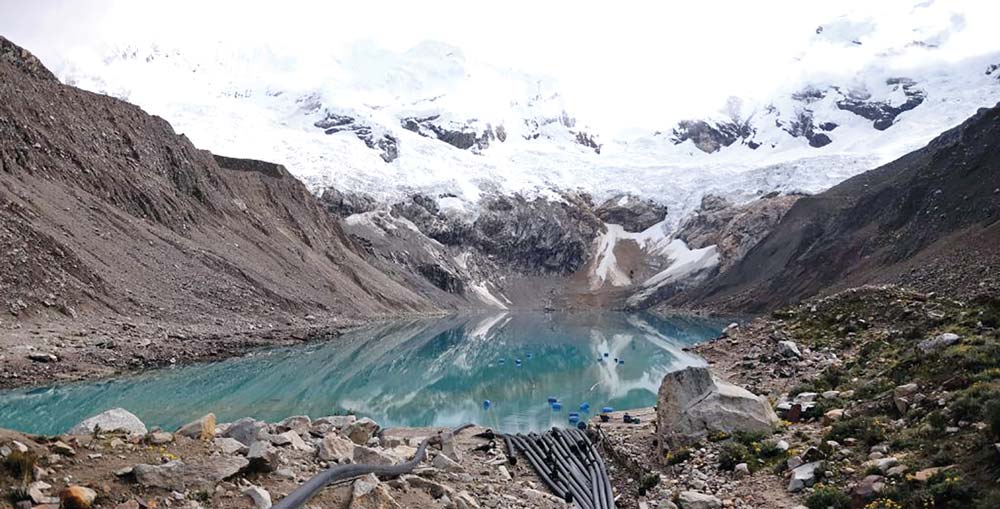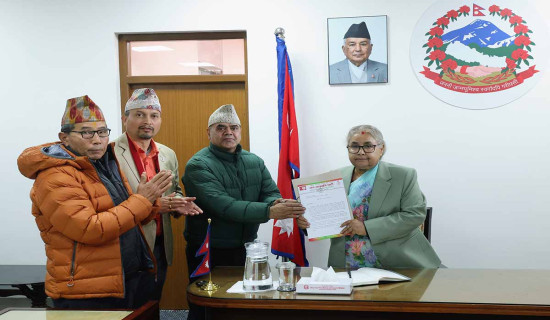- Thursday, 11 December 2025
Glacier melt hampers livelihood of downstream communities
Kathmandu, June 23: When Phu Sherpa, an icefall doctor, started his work in 2015, he found plenty of solid ice while securing routes through the Khumbu Icefall on Mt. Everest. Now, he has noticed a significant decrease in snow and ice. This change has made it harder to dig snow bars and place ice screws, which were easier tasks when there was more snow.
Phu has observed alarming glacier decreases on Lubuche Peak and Island Peak, near Mount Everest. Having climbed these peaks nearly 40 times, he noticed a significant reduction in glacier size.
Starting as an icefall doctor in 2015, Phu was on duty when the Gorkha earthquake struck Nepal. While many of his friends were injured, he escaped unharmed and continued working until two years ago. During his early years in his job, he saw plentiful ice, but now, many areas have turned into bare black rock. “Not everywhere, but in some places, the volume of ice is decreasing, as we noticed during our ice bar digging process,” he said.
Phu stopped working as an icefall doctor in 2022 due to family pressure, but he plans to return to the profession next year. He has observed that the diminishing ice and glaciers are having a significant impact on local communities. The decline in timely snowfall makes it difficult for farmers to plant seasonal crops, and the crops they do plant yield less than before. Even though tourism is their major source of income, the fastest melting glacier may hamper both tourism and potential long-term water availability to the entire community and the downstream community.
An article published in Climate and Atmospheric Science on Mt. Everest’s Highest Glacier is a Sentinel for Accelerating Ice Loss in 2022 showed that mountain glacier systems are losing volume globally. Still, there's limited information on their upper reaches above 5,000 metres.
The research, conducted using the world's highest ice core and automatic weather stations, showed that melting and sublimation significantly contribute to the mass loss of Mount Everest’s South Col Glacier (8020 m).
The glacier has been losing ice since the 1950s, with the thinning rate reaching nearly two metres per year since the late 1990s. This rapid melting is exposing underlying black ice, accelerating the melting process further. If current trends continue, this glacier could disappear by mid-century, the study said.
International Mountain Guide Narendra Shahi Thakuri, who is currently at Iceland's Arctic Ocean summit, said that snow levels were declining worldwide and that Nepal's mountains were not exempt from this impact. Thakuri, who has already summited mountains of Russia, Italy, Switzerland, and Iceland, including Mt. Everest five times, said that due to the low snow volume, lowland communities were victimised by rock falls and dry landslides.
“Most of the communities of Thukla, Labuche, and Lopche in the Everest region are facing transportation problems as rock falls block roads and destroy bridges. Often, rapidly melting glaciers block river channels, causing destruction when they release at high volume,” Thakuri said.
Another Everest summiter, Phurba Sherpa, who started climbing Everest in 2013, said that the level of snow has decreased in the last decade. “There are a lot of small ponds formed due to glacier melt, especially in Namche. The ice is not as stable as before, and ice breakage is found in various places. The river flow through the base camp has also increased compared to previous years,” he added.
The team of expeditions has also been facing a hard time due to unpredictable weather conditions in the past few years. He experienced heat in the camps and sudden unexpected cold at the summit. “Everest is not like before, the risk of dry avalanches is increasing with the ice breakage,” he added.
A recent annual Snow Update Report published by the International Centre for Integrated Mountain Development (ICIMOD), said that the Hindu Kush Himalaya experienced significantly lower snow persistence in 2024, the second lowest since 2003, with 2018 being the lowest. In 2024, snow persistence was 18 per cent below normal, compared to 19 per cent below normal in 2018.
The snow persistence has been studied in 12 major rivers of HKH including the Amu Darya river basin, the Brahmaputra River basin, the Helmand River basin, the Indus River basin, the Irrawaddy River basin, the Mekong River basin, the Salween River basin, the Tarim River basin, Tibetan Plateau, Yangtze River basin, and Yellow River basin.
Overall, snow levels are almost 20 per cent below normal this year, with the west seeing the most significant declines, where its contribution to water supply is crucial, the report revealed.
Sher Muhammad, ICIMOD Cryosphere Specialist and author of the Snow Update Report 2024 said that snowmelt is a crucial water source for the river basins in the HKH region, contributing about 23 per cent on average to the annual runoff in the 12 major river basins.
However, the amount of seasonal snow fluctuates significantly from year to year. In years with lower snow accumulation during winter, like this year, there will be less snowmelt in early summer, leading to water shortage for agriculture, hydropower, and other sectors if there is less rainfall in the early melt season.
Impact of rapid glacier melt
The changing climate has altered agricultural patterns in the Himalayan regions. Warmer temperatures have allowed farmers to grow crops that were previously unsuitable for high-altitude conditions, such as tomatoes, cucumbers, and various vegetables, said Phu. While this provides short-term agricultural benefits, it signals broader environmental shifts that could have long-term negative impacts on local ecosystems.
Muhammad said that reduced snow accumulation directly impacted agricultural productivity. Countries along HKH depend heavily on irrigation from aforementioned river basins. A decrease in water flow can lead to lower crop yields and threaten food security.
Also, hydropower in the region depends on a steady flow of water. Reduced snow can decrease the capacity of these plants to generate electricity, impacting energy supply and stability in the region, he said.
Mitigation strategies
According to Muhammad, planting native tree species could help the ground retain more snow. Forests act as natural water reservoirs, slowly releasing water over time and maintaining stream flows.
Improving weather forecasting and early warning systems can help communities prepare for water stress. Accurate predictions of water availability are crucial for agricultural planning and water management, he said.
“Investing in better water storage and distribution systems can mitigate the impact of reduced snowmelt. This includes building reservoirs, improving irrigation systems, and repairing existing infrastructure,” he said.
Developing policies to protect areas that receive snowfall and promoting regional cooperation are essential. Joint efforts among HKH countries can be instrumental in better water management practices and sustainable use of shared water resources.
“Addressing the root cause of climate change is crucial. Reducing greenhouse gas emissions can mitigate the warming trends that contribute to decreased snow accumulation. This requires a global effort, particularly from high-emission countries especially G-20 contributing to 81 per cent of emissions, to transition to renewable energy sources and reduce reliance on fossil fuels,” Muhammad said.
Communities’ involvement in local, and national level decision-making and promoting regional cooperation are vital for comprehensive solutions for the sustainability of snow.
Scientist Dr. Hemu Kafle of the Kathmandu Institute of Applied Sciences said that less snowfall means a long-term shortage of water resources for downstream communities. “Most of our rivers are snow-fed, and hydropower production also depends on these rivers. Therefore, reduced snowfall will impact both the irrigation system and clean energy production in the country, affecting the entire ecosystem.”
The water level in Tarai is also decreasing rapidly. Therefore, the options now are rainwater harvesting and a tree-based economy. “The government should prioritise rainwater harvesting and an agro-economy as adaptation measures, otherwise, the global impact of rising temperatures will certainly affect mountainous countries like ours,” Dr. Kafle said.
Due to the rise in global temperatures, the impact on the entire ecosystem has become evident. Species are shifting their ranges, and changes in community composition have been observed, experts said.
According to Peoples Climate Vote 2024 by the United Nations Development Programme (UNDP), the more people reported experiencing worse than usual extreme weather events, like droughts, flooding, storms and extreme heat or cold, the more likely they were to think about climate change, worry about it and factor it into big decisions, such as where to live and work or what to buy.
The report also revealled that those who had experienced worse-than-usual extreme weather over the past year were more likely to have thought about climate change at least weekly (by 19 per cent points), have increased their worry about it (by 37 per cent points) and have factored it into big decisions (by 20 per cent points).







-square-thumb.jpg)









